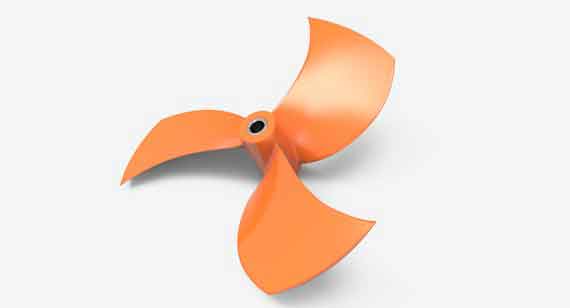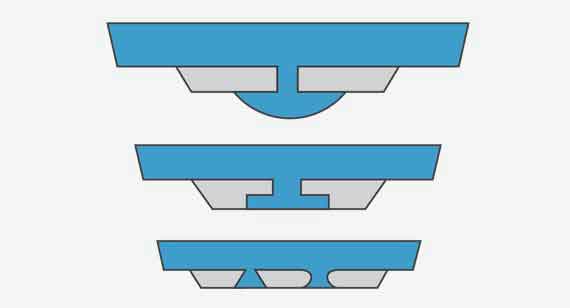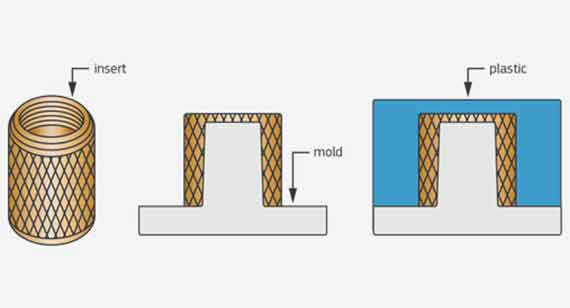Overmolding is an injection molding process that allows an additional layer of resin to be added to an existing molded part to provide a combination of characteristics that no single material can provide. One of the most common applications is to add a soft, functional, hand-friendly layer of rubber-like material,typically a TPE (thermoplastic elastomer) over a hard substrate. Another is to change or enhance the appearance or “cosmetics” of a part by overmolding material of a different color or finish to it. Overmolded materials can be found on anything from medical devices and hand-tools to toothbrushes and as gaskets and seals within assemblies.

As a manufacturing process, overmolding can provide excellent adhesion between different materials and eliminate the need to assemble materials by hand. Because the process can be automated to varying degrees it can be quite cost-effective. And, by reducing the complexity of assembly, it can help reduce costs and accelerate products and devices to market. But most important, it can greatly enhance the range of material characteristics available to a product developer.
There are two primary methods for overmolding—two-shot molding and pick-n-place molding, with the former using a single production mold while the latter uses two molds.
Material selection for overmolding can be complicated. Substrate and overmold resins can complement one another, but to be effective, they have to be compatible. Choices vary not just with the application of the overmolded part, but also with the method being used to produce it. Because process and outcomes are more complex for overmolding than for single-shot injection molding, it is helpful to seek input from resin experts when selecting materials.
Two-Shot vs. Pick-n-Place Overmolding
Let’s first look at two-shot molding, which involves a substrate that is molded in one material and then quickly overmolded with another material. This is generally a highly automated process. The second method is pick-n-place molding in which an entire batch of substrate parts is molded; the substrate parts are then manually placed, one at a time, into a second mold into which the overmolded resin is injected to produce the completed parts.
There are three primary methods for two-shot molding:
- Transfer overmolding is a robotic procedure in which substrate parts are mechanically lifted out of one mold and placed into another, larger mold. The overmolded material is injected to fill the empty space in the second mold, typically while the next substrate is being produced in the first mold.
- Rotational overmolding is another robotic process in which the mold itself moves from one injection station to another to allow injection of substrate and overmolded materials.
- Core-back overmolding can be used only with very specific linear geometries. The mold is built with a sliding section that is pulled back after the first material is injected and set to make room for the second injected material.
All three two-shot methods layer the overmolded material onto a warm substrate, which aids chemical bonding. All three also require specialized equipment and expensive molds, but because they are highly automated, they are cost effective for high-volume production, typically more than 10,000 pieces, and often 100,000 or more.
Pick-n-place molding uses two completely separate molds. A batch of substrate parts are manufactured in one mold and allowed to cool. They are then placed, by hand, into the second larger mold, which accommodates the substrate parts and leaves room for the overmolded material to be injected over the substrate. The process uses less complex equipment and simpler molds than the two-shot methods and simplifies and accelerates setup.
Comparing Overmolding Methods
While the manual placement of substrates into secondary molds is slower than the robotic processes, it can typically complete production of low to medium volumes of parts more quickly and at significantly lower cost. The biggest challenge in pick-n-place molding is the reduction in chemical bonding between overmolded materials and cool substrates. To maximize adhesion, substrates must be carefully handled to prevent contamination of surfaces that could impact adhesion. In addition, proper material selection also helps ensure good bonding in a pick-n-place application.
| Factors favoring two-shot molding | Factors favoring pick-n-place molding |
|---|---|
| Large production volume—typically over 10,000 parts |
Modest production volume—typically under 10,000 parts |
| Certainty of the design and materials you will use for the entire production run |
Need to prototype design or test materials, or possibility that the design will change |
| Time and money to invest in costly two-shot molds and process |
Need to move products and devices quickly to market or to meet market demand while two-shot molds are being made |
| Need for maximum chemical bonding between layers |
A design that specifies chemical bonding, and, through proper material selections, can provide a strong chemical bond |
The Role of Bonding
Bonding between resin layers helps keep the layers from separating. Depending on the part geometry, bonds can be subjected to several forces that can pull the layers apart.
These include:
- direct tensile pull causing separation at a butt joint
- shearing caused by a pull parallel to the bonded interface causing separation at a lap joint
- peeling that typically begins at an edge and propagates along the interface between materials
Bond strength is particularly important when one of the materials is an elastomer, which can flex and be pulled away from the substrate. This applies to both thermoplastic elastomers, which soften when reheated, and thermoset materials, which do not soften.
There are two primary ways in which layers bond. One is actual chemical bonding at the interface of the two resin layers; the other is mechanical bonding, which depends on the physical geometry at the interface. Acceptable bonding is achieved through a combination of part design, material selection, mold design, and molding process.
Chemical bonding takes place at the molecular level and is affected by several factors. The first is the wetting ability of the substrate by the injected overmolded material. Better wetting allows more contact between the two materials and more opportunity for bonding. This is a factor of temperatures of the materials, viscosity of the overmolded material, and texture and porosity of the substrate surface. At the interface, adhesion can take place in three different ways:
- mechanical entanglement of the polymer molecules
- co-crystallization
- chemical reaction between the polymer chains
Adhesion can also entail a combination of the three, and a textured surface increases the area over which adhesion can take place. In addition to the need for compatibility of the resins themselves, the presence of additives, fillers, and certain surface treatments can reduce the chemical interactions of substrate and overmolded materials.
Molders and material suppliers can be a valuable resource in identifying resins that both meet the designer’s performance requirements of the completed part, and resins that are compatible with one another and able to provide maximum adhesion. Processing can also significantly impact adhesion. This is particularly true in pick-n-place molding. In this process, the substrate is allowed to cool before overmolding and is both exposed to the environment and handled during the process. It is critical that the manufacturer prevent the accumulation of impurities on the substrate surface during storage and handling in order to maximize adhesion—an area that China Metal Parts pays close attention to.
Mechanical bonding can be used in place of or in conjunction with chemical bonding. When overmolded resin flows into holes in the substrate, particularly if the holes are “dovetailed” to widen at the bottom, the cooled overmolded material is locked to the substrate. Other ways to enhance mechanical bonding include wrapping the overmolded material around the substrate or increasing surface area of the interface with grooves, pickets, posts, or bosses. A porous substrate provides tiny holes into which an elastomer can migrate to create a mechanical bond. To prevent peeling, avoid exposed edges of the overmolded material. A raised edge of substrate material can protect the edges of the overmolded elastomer where peeling could otherwise begin.
Chemical Bonding Compatibility
| SUBSTRATE MATERIAL | ||||||
|---|---|---|---|---|---|---|
| OVERMOLD MATERIAL | ABS LUSTRAN | ABS/PC CYCOLO C2950-111 | PC LEXAN 940-701 | PBT VALOX 357-1001 | PP PROFAX 6323 | NYLON 66 ZYTEL 103 HSL NC010 |
| TPU-Texin 983-000000 | C | C | C | C | M | M |
| TPV-Santoprene 101-87 | M | M | M | M | C | M |
| TPE-Santoprene 101-64 | M | M | M | M | C | M |
| LSR-Elastosil 3003/30 A/B | - | - | M | M | - | M |
| TPC-Hytrel 3078 | C | C | C | C | M | M |
| TPE-Versaflex OM 1060X-1 | C | C | C | M | M | M |
| TPE-Versaflex OM 6240-1 | M | M | M | M | M | C |
| TPE-Versaflex OM 6258-1 | M | M | M | M | M | C |
| TPE-Versaflex OM 1040X-1 | C | C | C | M | M | M |
M = mechanical bond C = chemical bond

Overmolding Materials
Thousands of possible combinations exist of substrate and overmolded material. A few of the more common possibilities are included in the aforementioned chart, but if you require special characteristics, there are many others that can be identified by material suppliers.
Besides compatibility and adhesion, there are a number of factors that affect resin choice for overmolding. If the goal is cushioning, the thickness of the overmolded material can be as important as the softness of the material itself. Thin layers, typically below 0.40 in. (10mm), will feel hard regardless of material choice. For this reason, many consumer products will have rows of taller ribs, to increase perceived thickness while reducing the amount of overmolded material and increasing its flexibility. The actual flexibility of a material is not directly related to its hardness or durometer. A better measure is flexural modulus, which measures a material’s resistance to bending. A material with lower flexural modulus will feel softer. And while a variety of resins are suitable for overmolding, there are elastomers such as Versaflex that can be specifically formulated for overmolding applications.
If the goal of overmolding is to enhance grip, a material’s coefficient of friction indicates how tactile it will be. Thermoplastic elastomers (TPEs), for example, generally have a high coefficient of friction. As in the case of cushioning, durometer is not a reliable measure of a material’s grip. Since many resins including both thermoplastics and thermosets can have a range of characteristics, it may be useful to consult experts in choosing the right resin grade for a specific application.

Like overmolding, insert molding injects a resin over another material, but instead of a plastic substrate the other material is typically metal and the injected plastic material is typically a rigid plastic. Metal electrical components or custom-machined metal parts are often embedded in plastic this way. Similarly, threaded inserts can be molded into plastic parts for stronger, more durable assembly of plastic components such as device shells. Insert molding is an alternative to inserting metal parts by either heat staking or ultrasonic welding, processes by which a molded plastic part is locally melted to allow the insertion of a metal part. Insert molding is more controllable and allows better encapsulation than the other methods. Molded in inserts also eliminate the need for a secondary insert installation process, saving time and money.
Because inserts are metal, they must be placed into a mold in which they will be encapsulated in plastic. This can be done robotically for high volume production, but for low- to mid-volume production insertion into the mold, pick-n-place is a manual process. There is no chemical bonding between metal inserts and plastic, so the insert and resin components must be designed for mechanical bonding.
China Metal Parts accepts pre-fabricated inserts, including PEM, Dodge, Tri-Star, Spirol and Tappex.
Why Use Overmolding and Insert Molding?
While overmolding requires more complex design, processing, and materials choice than single-shot injection molding, it offers significant benefits:
- It allows materials to be combined to provide characteristics that no single resin can deliver.
- It can eliminate assembly steps, saving both time and money.
- It can meld materials in a way that assembly processes cannot match.
- Inserts add strength and durability to parts.
Cost Reduction
Overmolding can reduce production cost. Whereas standard injection molding can combine multiple parts into a single multi-cavity mold, overmolding can produce a single part made up of different materials without the need for assembly. Mold production is more complicated, but it eliminates the recurring cost of assembling thousands of parts. There are a variety of ways to produce overmolded parts, and choosing the right one for your needs—time to market, total production volume, and likelihood of product change—can help determine which will be most efficient.
Quick-turn Production
Overmolding can reduce production cost. Whereas standard injection molding can combine multiple parts into a single multi-cavity mold, overmolding can produce a single part made up of different materials without the need for assembly. Mold production is more complicated, but it eliminates the recurring cost of assembling thousands of parts. There are a variety of ways to produce overmolded parts, and choosing the right one for your needs—time to market, total production volume, and likelihood of product change—can help determine which will be most efficient.
Prototyping and Low-Volume Runs
Pick-n-place overmolding is ideal for low- to mid-volume production. Because it is more labor-intensive than two-shot overmolding, production cost per part using this technique will tend to be higher, but it eliminates the extremely high cost and delay of producing complex two-shot molds. Total cost of pick-n-place will tend to be lower than two-shot below production volumes of 10,000 parts. The process can also be used to produce prototypes before investing in two-shot molds for high-volume production. If speed to market is critical, it may make sense to use pick-n-place to deliver product to market
while waiting for full-scale production to begin. And, in markets where parts are subject to frequent redesign, pick-n-place reduces risk by allowing redesign of molds at a fraction of the cost of remaking two-shot molds.
Range of Applications
Overmolding is widely used in industries ranging from consumer products to automotive and electronic components, but it is particularly suited for medical and health care applications. Devices that contact, enter, or are inserted into the body may have to meet stringent requirements and have challenging functions. They may have to stand up to heat for sterilization, endure chemical exposure, and meet standards including FDA, USP Class VI, ISO 10993, and biocompatibility. In many cases, no single resin can meet all of the requirements. For safety and sterility, multiple materials may have to mate virtually seamlessly, and this is an area in which overmolding excels. There are many other reasons to use overmolding including:
- One of the most common is for comfort and grip. Soft elastomers are frequently molded over a hard substrate to create a safe, non-slip grip on a variety of hand-held items ranging from hand tools to devices.
- Because the overmolded material is typically an elastomer, sealing, shock absorption, and vibration damping are also common applications.
- Another common application is aesthetic; the substrate can have an indented pattern that is filled with the overmolded material in a contrasting color to create text, a logo, or other design.
- Overmolding can change the characteristics of a part’s surface to give it different electrical, thermal, or other environmental qualities.
- It can also be used to capture or encapsulate something within another material.